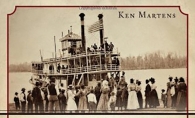Stillwater is known for its charming streetscapes and historic riverside, but a part of the city’s downtown is hidden beneath rock and concrete. Known as the Joseph Wolf Brewery caves, caverns dating back to 1868 were cut into the section of the sandstone bluff located off of Main Street, where the restaurant Luna Rossa Trattoria and Wine Bar sits today. Luna Rossa offers tours of the caves, which could add a fun element to your next date night or riverside afternoon.
Leaving the bar at Luna Rossa, guests on these tours take a step back in time, entering the space 40 to 60 feet below the hillside, where the markings from pick-axes and blast holes that carved out the cave system remain prevalent to this day. The sound of trickling water welcomes you inside, as your underground adventure begins with a natural spring around which the cave was designed and used for brewing beer. “The water has been tested to be more than 95 percent pure,” says Jordan Junker, a tour guide who leads an informative lesson on cave construction, historical usage and bootlegging rumors.
Junker’s great-grandfather used to work in the caves. “It doesn’t matter if it’s 100 degrees or 20 degrees outside, it always stays a constant 52 degrees in here year round,” she says, adding that the cave construction was likely influenced by the brewing tradition in Switzerland that used cave systems as a natural coolant for the beer.
The caves, wooden buildings and brewhouse on the property were constructed by Martin Wolf and sold to his brother Joseph, who eventually named the property Wolf Co., brewing and distributing Empire Beer. “[The year] 1919 was its most successful. They sold more than 25,000 barrels of beer through here,” Junker says. However, with Prohibition, the company shut down beer operations. The Wolfs attempted a sparkling water and soda business, but after little success they closed in 1925.
Today, tours wind through the 10,000 square feet of moss-covered caverns that contain historical relics of pre- and post-Prohibition-era Stillwater, including scales, bottles and a flatbed wagon used to transport the beer via the rail system. There are also a series of intriguing hidden passageways.
In 1945, Tom “the Cave Man” Curtis purchased the caverns. Curtis also owned a tractor and feed store, which today is the Freight House restaurant. He flooded the caves and stocked them with trout, giving tourists a narrated boat tour with wild tall tales and the semi-controlled opportunity to fish. “The caves were one of Stillwater’s first tourist attractions,” says Brent Peterson, executive director of the Washington County Historical Society. “The development of that attraction signaled the start of the transition of Stillwater from an industrial community to a tourist destination.”
Curtis later collaborated with the Gozzi family, who opened the fine Italian restaurant Vittorio’s, known for food and ambience, and the Blue Grotto, which provided a popular dining experience overlooking the cave’s water feature. Vittorio’s also returned to brewing beer, available only on tap in the restaurant. The restaurant and caves changed owners several times until chef Raffaele Virgillo purchased the restaurant in 2001, and renamed it Luna Rossa Trattoria and Wine Bar; in 2007 he purchased the cave system as well.
If You Go
A basic 30-minute tour is available for $7, which offers an informative history about the caves. A more extensive tour, with a wine tasting and appetizers included, is available for $32 for two (reservations are required, and guests must be at least age 21). This experience includes a 30-minute tour, plus samples of three chef-selected wines, and appetizers and warm bread in the candlelit caves, an homage to the history of fine Italian dining on the property.
A few tips: Dress for the cool cave temps. The condensation in the caves makes the floor damp, so wear appropriate footwear. And don’t worry—there are no bats. Visit the website for tour days and times.









